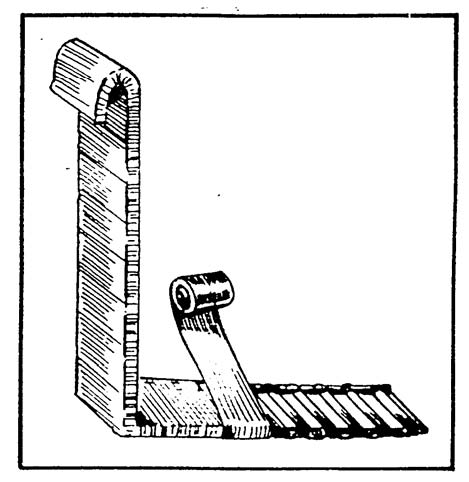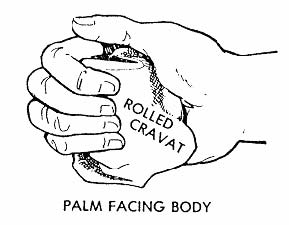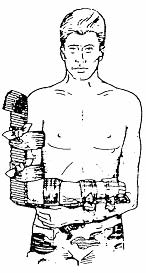Treating Fractures in the Field
Lesson 5: Fractures of the Upper Extremities
5-1
5-1. IMMOBILIZE AN ARM WITH A WIRE LADDER SPLINT
A wire ladder splint can be used to immobilize a fracture of the forearm, a fracture of the humerus, a fracture of the elbow when the elbow is bent, or an arm with multiple fractures.
a. Prepare Wire Ladder Splint.
(1) Bend the prong ends of the splint away from the smooth side. About 1.5 inches should be bent.
(2) Place the smooth side of the splint against the casualty's uninjured arm with the bent end even with the top of the uninjured shoulder.
(3) Select a point slightly below the casualty's uninjured elbow.
(4) Remove the splint from the casualty's arm and bend the splint into an "L" shape at the selected point. The smooth side of the splint should be on the inside of the "L" and the bent prong should be on the outside.
(5) Pad the splint by wrapping a roller bandage around it (see figure 5-1) or by applying leaves, material, or other padding on the inside of the splint. If padding materials are not available, apply the splint without padding.
Figure 5-1. Padding a wire ladder splint with a roller bandage.
b. Apply the Wire Ladder Splint.
(1) Position the splint on the outside of the casualty's injured arm with the bent prongs away from the shoulder.
(2) The angle of the splint should extend beyond the elbow and not touch the elbow. The splint should not place pressure on the elbow. The upper arm, forearm, and hand will have contact with the splint.
(3) Check the distal end of the splint. If the splint does not extend beyond the ends of the casualty's fingers, use a basswood splint or other device to lengthen the splint.
(4) If possible, have the inside of the casualty's hand and forearm toward his chest.
(5) If possible, have the casualty support the splint and injured arm.
c. Apply Wad to Hand. Place a rolled cravat or similar material in the palm of the casualty's injured hand (see figure 5-2).
Figure 5-2. Rolled cravat placed in palm of injured hand.
d. Check Pulse. Check the casualty's pulse below the fracture site. If no pulse is found, evacuate the casualty as soon as possible after the upper arm is splinted.
(1) If there is no pulse, one attempt should be made to pull traction on the arm to restore the pulse.
(2) If the casualty has extreme pain or resistance is felt, the attempt should be stopped and the limb splinted in place.
e. Secure the Wire Ladder Splint.
(1) Apply five cravats to the wire ladder splint (see figure 5-3).
Figure 5-3. Wire ladder splint applied to an injured arm.
(a) Apply two cravats to the upper arm. If the humerus is fractured, apply one cravat above the fracture site and one cravat below the fracture site. Do not apply a cravat over the fracture site.
(b) Apply two cravats to the forearm. If the forearm is fractured, apply one cravat above the fracture site and one cravat below the fracture site. Do not apply a cravat over the fracture site.
(c) Apply one cravat around the hand and splint in an "X" pattern.
(2) Tie the tails of the cravats in a non-slip knot on the outside of the splint. Tuck the ends of the tails into the cravat.
(3) Check the casualty's pulse after each cravat is applied. If the pulse can no longer be detected, loosen the cravat and apply it again. If this does not restore circulation, evacuate the casualty as soon as possible.
f. Apply Sling and Swathes. Apply a sling and swathes to further immobilize the casualty's arm. Slings and swathes are discussed in paragraphs 5-8 and 5-9.
(1) If the humerus is fractured, apply two swathes--one above the fracture site and one below the fracture site.
(2) If the humerus is not fractured, make the swathe wide across the injured arm.




